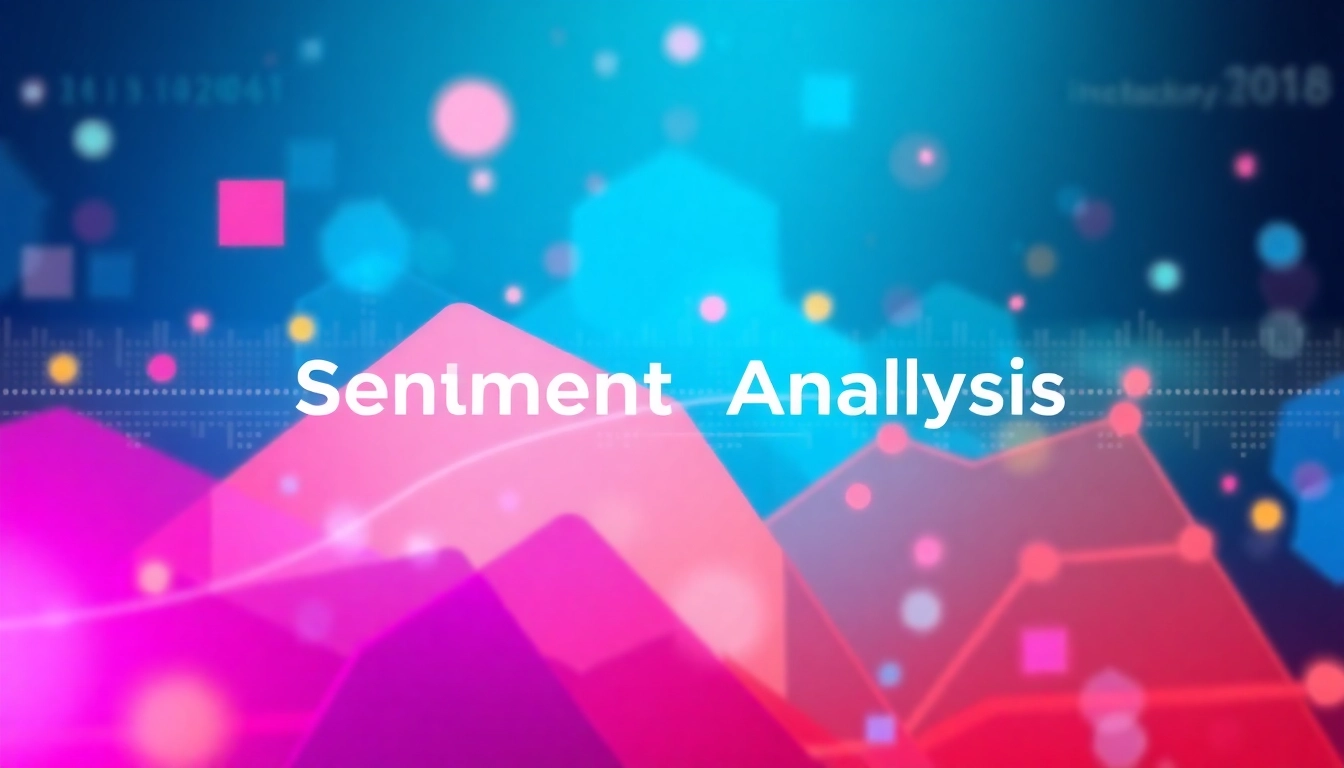Understanding AI Sentiment Analysis
What is Sentiment Analysis?
Sentiment analysis, often referred to as opinion mining, is a crucial branch of natural language processing (NLP) that focuses on determining the emotional tone behind a body of text. By leveraging advanced computational methods, sentiment analysis enables the systematic identification of attitudes, opinions, and emotions expressed in written language. This analysis can classify sentiment into categories such as positive, negative, or neutral, allowing businesses to gauge customer opinions and emotional responses to products, brands, or topics. As technology evolves, AI sentiment analysis has become more sophisticated, providing deeper insights into consumer behavior and preferences.
Importance of Emotional Insight in Marketing
The value of sentiment analysis in marketing cannot be overstated. In today’s hyper-competitive marketplace, understanding how customers feel about products and brands is pivotal for success. Companies can employ sentiment analysis to analyze customer feedback in real-time, offering them the ability to adapt strategies promptly based on public sentiment. This not only enhances customer satisfaction but also fosters brand loyalty, as consumers feel heard and valued. Emotional insight derived from sentiment analysis can inform marketing strategies, product development, and customer service innovations that are more aligned with consumer desires.
Common Applications in Various Industries
Sentiment analysis transcends specific industries; its applications are wide-ranging and impactful:
- Retail: Retail businesses use sentiment analysis to assess customer reviews and feedback, enabling them to tailor products and services to meet consumer expectations.
- Finance: Financial institutions utilize sentiment analysis to interpret market trends based on social media commentary and news articles, providing valuable insights for decision-making.
- Healthcare: In healthcare, sentiment analysis is applied to patient feedback to improve services and understand treatment outcomes better.
- Travel and Hospitality: Companies in this sector analyze customer sentiment related to service quality and experiences to enhance operational efficiencies.
- Entertainment: The entertainment industry employs sentiment analysis to gauge audience reception of films, shows, or live performances, guiding future projects.
Techniques Behind AI Sentiment Analysis
Natural Language Processing (NLP) and Its Role
Natural Language Processing (NLP) is the cornerstone of sentiment analysis. It enables machines to understand, interpret, and respond to human language in a valuable way. NLP techniques such as tokenization, part-of-speech tagging, and syntactic parsing are used to break down text into manageable components, allowing AI systems to analyze sentence structure and semantics thoroughly. Additionally, sentiment classification relies on various NLP models to discern the emotional context, whether through keyword matching, rule-based classification, or deep learning models.
Machine Learning Algorithms Used
Different machine learning algorithms play pivotal roles in sentiment analysis, each having its strengths and weaknesses. These algorithms include:
- Supervised Learning: Supervised techniques such as logistic regression, support vector machines (SVM), and decision trees are trained on labeled datasets to predict sentiment based on learned patterns.
- Unsupervised Learning: Algorithms like clustering can identify natural groupings within datasets, exploring ideas without predefined categories, which is useful in exploratory sentiment analysis.
- Deep Learning: Advanced techniques, especially those utilizing neural networks (e.g., LSTM, CNN), have gained traction due to their ability to capture intricate features in large datasets, providing higher accuracy in identifying sentiment.
Data Sources for Effective Analysis
The effectiveness of AI sentiment analysis hinges significantly on the quality and diversity of data sources utilized. Common sources include:
- Social Media: Platforms like Twitter and Facebook provide rich, real-time data that reflects public sentiment about current events, brands, and products.
- Customer Reviews: E-commerce sites like Amazon and Yelp contain vast amounts of customer-generated data that are goldmines for sentiment analysis.
- Surveys and Questionnaires: Direct feedback through structured surveys enables businesses to obtain targeted insights into customer perceptions.
- News Articles and Blogs: Analyzing editorial content and opinion pieces can reveal broader societal sentiments influencing consumer behavior.
Implementing AI Sentiment Analysis in Your Business
Steps for Integration into Existing Systems
Integrating AI sentiment analysis into existing business systems requires a strategic approach to ensure optimal results. Here are the key steps:
- Define Objectives: Clearly outline the goals you aim to achieve with sentiment analysis, such as improving customer experience or enhancing product offerings.
- Choose the Right Tools: Select the appropriate sentiment analysis tools and platforms that align with your objectives and data capabilities.
- Data Collection: Gather a diverse array of data sources for analysis to ensure comprehensive coverage of customer sentiment.
- Model Training: Train your sentiment analysis model using labeled datasets to enhance its ability to classify and predict sentiments accurately.
- Implementation and Monitoring: Deploy the sentiment analysis model within your existing systems, continuously monitor its performance, and iterate as necessary.
Tools and Resources Available
A wealth of tools and resources are accessible for performing sentiment analysis, ranging from open-source libraries to commercial offerings:
- NLTK: The Natural Language Toolkit (NLTK) is a powerful Python library for text processing and sentiment analysis, ideal for beginners.
- TextBlob: TextBlob simplifies text processing, allowing users to conduct sentiment analysis with minimal coding experience.
- IBM Watson: IBM’s cloud-based AI tools offer comprehensive sentiment analysis capabilities suitable for enterprises seeking robust solutions.
- Google Cloud Natural Language API: This API provides sentiment analysis as part of a broader suite of NLP capabilities, ideal for SaaS applications.
Case Studies of Successful Implementations
Several organizations have successfully harnessed AI sentiment analysis to transform their business operations:
- Starbucks: By analyzing customer feedback across social media and review platforms, Starbucks identified key areas for improvement in service, which resulted in enhanced customer satisfaction scores.
- Spotify: Spotify utilizes sentiment analysis to understand how listeners feel about new music releases, helping them curate playlists that resonate with their audience.
- HubSpot: The marketing software company employs sentiment analysis to gauge customer feedback on their content and features, enabling data-driven content strategies.
Challenges and Solutions in AI Sentiment Analysis
Common Pitfalls to Avoid
While implementing sentiment analysis can offer significant benefits, several common pitfalls should be navigated:
- Overlooking Data Quality: Poor-quality data can lead to inaccurate insights. Ensuring that data sources are reliable and relevant is crucial for meaningful sentiment analysis.
- Ignoring Context: Sentiment can greatly differ based on contextual factors; failing to consider the broader context of comments can skew results.
- Neglecting User Experience: Complex or unintuitive sentiment analysis tools can frustrate users. Prioritizing ease of use in tool design is essential.
Addressing Bias in AI Models
AI models are susceptible to biases present in training data, which can skew sentiment analysis results. Strategies to mitigate bias include:
- Diverse Datasets: Training models on diverse datasets that encompass various demographics and perspectives can help reduce bias in sentiment classification.
- Regular Monitoring: Continuously monitoring model outputs and adjusting for bias as new data comes in helps maintain accuracy and fairness over time.
- Transparency in AI: Fostering transparency in how AI models are developed and the data sources used can help businesses identify potential sources of bias.
Enhancing Accuracy with Data Quality
Improving the accuracy of sentiment analysis depends heavily on the quality of data. Here are some measures to enhance data quality:
- Data Curation: Regularly curating and cleaning datasets ensures that outlier or incorrect data is removed, allowing models to be trained on the best information.
- Feedback Loops: Establishing mechanisms for implementing user feedback into the dataset helps to make sentiment analysis models more accurate over time.
- Combining Data Sources: Integrating multiple data sources can provide a more comprehensive view of sentiment, thereby improving overall accuracy.
Future Trends in AI Sentiment Analysis
Emerging Technologies Shaping the Field
The landscape of AI sentiment analysis is continuously evolving. Some emerging technologies include:
- Generative AI: Enhancing sentiment analysis by analyzing wider contexts and producing more nuanced results based on extensive datasets.
- Edge Computing: Processing data closer to the source can enable real-time sentiment analysis, allowing businesses to respond promptly to customer sentiments.
- Voice Sentiment Analysis: The growing importance of voice interfaces has led to advancements in analyzing sentiments expressed through voice data, opening new avenues for customer insight.
Predictions for Market Evolution
The sentiment analysis market is expected to witness substantial growth, with new tools and methodologies emerging to enhance its capabilities. Broad adoption across industries will likely spur innovations that facilitate more advanced understanding of human emotions through text and speech data.
How Businesses Can Stay Ahead
To remain competitive in a landscape enriched by sentiment analysis, businesses should:
- Invest in Training: Enhancing staff knowledge about sentiment analysis tools and methodologies can lead to better implementation and usage.
- Pursue Continuous Improvement: Routinely assess and update sentiment analysis practices to keep pace with technological changes and market trends.
- Focus on Ethical AI: Prioritize ethical considerations in AI deployment, fostering trust and transparency with customers.

